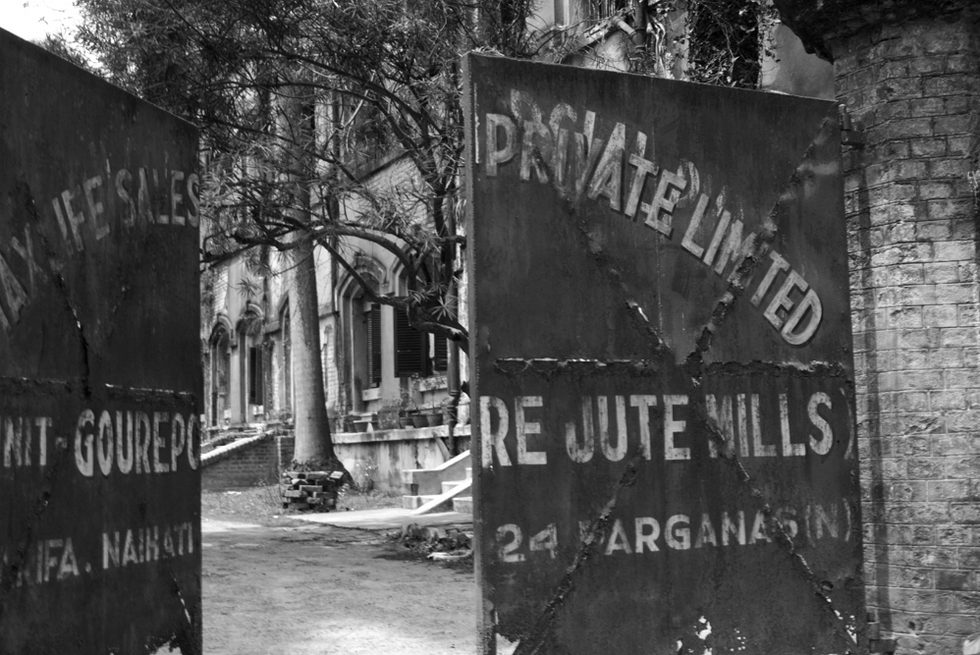
This essay is an immersive exploration of an abandoned industrial site, which addresses the degeneration of materials and the imagery of ruination. By visually exposing slices of an abandoned jute mill, I reveal how the experience of walking through such a space subverts normative modes of movement, vision, arrangement, and order while also drawing attention to how things lose their distinct material identities as they decay.
The journey takes place in the Gourepore Jute Mill, established in 1862. It is one of India’s oldest and largest jute mills, which at one point in time employed more than 10,000 workers. It also recruited 250 officers and 500 clerks before labor conflicts erupted between owners and union representatives. These events, together with dwindling demand for jute, led to the mill’s closure in the 1970s. Thirty kilometers north of Calcutta, the mill occupies over a hundred acres along the Hoogly riverbank in Naihati.
Its rusted, worn-out look has an emphatic and imposing presence. Its apparent abandonment contrasts starkly with the functional flow of life around it. The mill, enclosed by high walls that are no longer strong and protective, entices one to enter and see what lies within. The charm of the forbidden stimulated my curiosity to search out the unexplored and unseen.
As I enter the mill, I am touched by the grandeur of the vacuum that surrounds me. As my eyes get used to the catastrophe of cracks, my nostrils accustom themselves to dust and dampness, while my ears attune to a space devoid of urban cacophony. I realize that the apparent emptiness is full of details that narrate a story of disarray. Blending emotive sensibilities with analytical skills is thus essential to making sense of this indeterminate space. While technological shifts and the restructuring of capital have led to the abandonment of this production site, unregulated degeneration has led to the fragmentation of the materials lying before me. As I hesitantly make my way forward, I realize that there is no fixed path to follow; disorder is the undeniable norm here. The material remains and the images of degeneration that I produce overlap and form an interpretive key to this dysfunctional space.
Writing on archaeologies of the contemporary past emphasizes explorations of the ruins of modernity as an extension of a process of self-excavation, one that “exposes layers of different memories” (Olsen and Pétursdóttir 2014, 12). This is also an expressive process of discerning decay and decline through the activation of the senses: sight, sound, smell, and touch. The liminal and transient nature of modern ruins is captured by Tim Edensor (2005, 16), who writes that “derelict sites are in a fluid state of material becoming and can reveal the stages and temporalities of decay.” The sociologist Alice Mah (2008, 13) finds another way of describing the ongoing process of transformation: “At any given moment, a ruin appears as a snapshot of time and space within a longer process of ruination.” The stages of this process evoke a wide range of sensations as they are perceived. They share a connection with narratives and struggles of livelihood, collective memories of loss. They are linked with those who (legally or illegally) dwell in their surroundings. Yet, in contrast to the buzz of the everyday life around it, the ruined mill is characterized by silence, stillness, and lifelessness.
While Mah (2008, 2014) reveals the complexities of our relationship with the material truth of desolate, decaying spaces beyond use or repair, my objective is to emphasize the inseparability of visuality from this truth. The visuality of materials and the materiality of visuals mark the coexistence of decay’s visuality and created images of degeneration. This inseparability, experienced in a space of decay, decline, and degeneration, is the driving force for this photo-essay. By witnessing a dialogue between the visual and the material, viewers can observe how these two elements interact in an apparently dead zone of inactivity. Rather than mapping the sociological, political, or psychological impacts of the mill’s shutdown and the abandonment of its machinery, my aim is to emphasize the aesthetic enigma of an anarchic space and to consider how it might affect our senses. As I moved through and mapped this abandoned site, I used photography not merely as visual proof of the process of ruination but also as as a way of illuminating analytical points relating to the manufacturing sector’s demise. In doing so, I show how ruination leads to what I term the loss of material sovereignty—a process that unfolds as materials fragment over time and lose their distinct material/visual identities.
The Trajectory of the Golden Fiber: Its Advent and Demise
The nineteenth-century history of the city of Calcutta is inseparable from the expansion of one of India’s oldest industries—that of jute, also known as the “golden fiber.” Dipesh Chakrabarty’s (1989) work on jute mills and Leela Fernandes’s (1997) work on the gendered dimensions of mill labor chart the history of the industry in nineteenth-century Bengal by focusing on working and living conditions, organized labor movements, and relations of production. The first jute mill was set up in Rishra in the Hoogly District in 1855. Soon after, other mills popped up on either side of the Hoogly River in the southwestern region of an undivided Bengal. By 1920, close to a hundred mills employing over three million workers were in operation. The use of sandbags during World War I further escalated demands for this commodity. Much of the reason behind jute’s meteoric rise can be credited to mid-nineteenth century tensions between Britain and Russia, which forced jute mills in Scotland to find substitutes for Russian flax. This prompted Scottish industrialists’ decisions to set up production units along the banks of the Hoogly.
The industry’s rapid growth and expansion was ensured by the mills’ proximity to the thriving port of Calcutta, easy access to jute flax via the Ganges Delta, the growing demand for jute as a tougher alternative to cotton in the packaging and wrapping of goods for overseas markets, and most importantly the availability of cheap and unskilled local labor. Both banks of the river were soon dotted with mills in Bansberia, Halishahar, Kalyani, Naihati, Chandannagore, Kakinara, Shamnagar, Barrakpore, Serampore, Titagarh, Rishra, Agarpara, Bally, Howrah, Shibpur, Budgebudge and Uluberia. The golden fiber contributed 60 percent of India’s foreign exchange in the early 1950s, before increased competition with synthetic substitutes prompted its downfall.
The failure of the industry and its backers to successfully identify ways of saving this ailing mode of production is a well-established historical fact. However, other changes in production and consumption processes must be taken into account to fully understand jute’s collapse. The demise of the manufacturing industries under post-Fordism and the massive growth of the service sector contributed to the commodity’s irrelevance. The literature on ruination (Gross 1992; Buchli and Lucas 2001; Edensor 2005; Mah 2008, 2014; Yablon 2009; Harrison and Schofield 2010; Stoler 2013; Harbison 2015) acknowledges this shift from the industrial to the postindustrial as a hallmark of late capitalism and an active factor that reinforced the process of ruination and the creation of abandoned, redundant, desolate and marginal spaces. Such a shift can also be noted in the representation of industrial spaces in Indian popular cinema.1 Industrial sites like the Gourepore Jute Mill are often used to shoot fight scenes that appear toward the climactic end of film narratives. The omnipresent pillars and machinery provide a natural obstacle for gunshots, thereby intensifying cat-and-mouse chases on the screen. The prospect of falling wheels and chains further increases the threat and thus the thrill created by the space. Crucially, human absence ensures that the standoff can take place without the interference of an unwanted public. While earlier in the twentieth century, such spaces were shown as active spaces of production, increasingly (perhaps capturing India’s own shift to a postindustrial economy) these spaces have given way to abandoned and rusted (non)spaces that are waiting to be invaded by fictitious characters who intend to settle their accounts.
Susceptible to global trends of time-space compression and the replacement of assembly-line modes of production with principles of decentralized efficiency (Harvey 1990), labor can now be outsourced and components made across various parts of the world, to be tracked and assembled at different locations. Following David Harvey’s (2000) logic of creative destruction, capitalism has the power to produce, reproduce, and even destroy spaces when they cease to be profitable. It also possesses the power to decide what counts as waste.
Along with spatio-temporal changes in production processes, the principles of planned obsolescence bring an end to the lifespan of things by refusing to imagine or design commodities that are built to last. Instead, commodities are designed for limited or even onetime use. The ideal of “old is gold” is now replaced by the ephemeralist doctrine of here-and-now or new-and-improved. The curtailment of the lifespan of things and the accelerated pace of technological innovation prepares everything to be periodically trashed and upgraded. Obsoleteness is thus built into commodities (Strasser 1999; Kennedy 2007; Tischleder and Wasserman 2015), which come with predetermined dates of expiry. By rethinking the notion of expiration as permission to demolish, Zygmunt Bauman (2004, 94) rightly claims that production presumes consent to dismantle. The narrative of disposable plastic replacing durable jute is closely related to the use-and-throw tendencies encouraged by late twentieth-century production forces.
The Past Intrudes into the Present: Subverting How We View Materiality and History
The demise of the manufacturing sector, the practices associated with planned obsolescence, and the advent of lighter and more flexible materials like plastic sealed the fate of jute, forcing it toward irrelevance. However, the jute industry’s massive structures, which once defined the fate of millions, continue to spread across hundreds of acres. Quite a few mills are still functional, falling under the category of “sick” or surviving with great difficulty. The rest were abandoned and locked up after a series of conflicts between owners and laborers during India’s postindependence period. Regular labor conflicts were inevitable given the clash of interests between the maliks (owners) and mazdurs (laborers) and the shrinking profits generated by the industry as it failed to technologically upgrade or compete with alternative materials that became available in the 1960s and 1970s.
The tactility of the modern ruin is fundamentally different from that of the heritage site. Some ruins from the ancient or medieval past enjoy the privilege of being cared for, preserved. They can be consumed as heritage through strict protocols that guide their relationship with observers. These ruins have already reached a stage of material stability, a frozen, static state of being that contradicts Edensor’s idea of a “fluid state of material becoming.” Conversely, a modern industrial ruin is a vibrant example of a living past that intrudes into an experienced present. Visualizing a modern ruin, as Mah does, as a “snapshot of time and space within a longer process of ruination” is very much in sync with Bjørnar Olsen and Þóra Pétursdóttir’s (2014, 7) description of this ongoing process as a verb (that is, “to ruin”), as opposed to a conceptualization of the ruin as a noun.
Another distinguishing feature of a ruined factory is its obvious contradiction with the symbolically coded and commodified nature of a historical site, which is objectified in museums, memorials, statues, guided tours, information boards, and popular iconographies. Such a predictable tour through the relics of the past minimizes risks and uncertainties as it presents history as a tidy package.2 In contrast, the corrosive forces at work in a chaotic modern industrial ruin directly contrast with the externalization of memory that tends to occur in organized sites of representation like museums. The conditions of modernity create a rupture between past and present, thus necessitating the reconstruction of the past through material remains (Nora 1996; Tamm 2013). The ruins of the near past, however, make it possible to experience degenerative forces at work: to witness the variations of states of material becoming in an anarchic space devoid of management and maintenance.
Postscript on a Deviant and Liminal Space
The exploration of the visuality of the material and the materiality of the visual in a site of industrial ruination establishes the Gourepore Jute Mill as a deviant space that challenges our preconceived notions of visual, material, and social convention. Going through perpetual stages of aesthetic reordering also challenges our relationship with the visual and the material. The environment not only reshapes our physical movements as it compels us to adapt to its chaos, but it offers us unimaginable freedom to personalize our relationship with the abandoned materials and their visuals: to treat them in the manner that we wish. The uncertainty and unpredictability that repulses many people also offers a playground of possibilities that challenge hegemonic modes of physicality, sight, and social ordering prevalent in functional zones. Most importantly, these sensibilities caution against the temptation to succumb to the many standardization practices of our globalized world.
Like unclaimed dead bodies at the morgue, most of these mills stand abandoned in an ambiguous state, belonging to no one, waiting for the next legal hearing. Illegal visitors broach its weakening walls, as do insects and animals. Devoid of ownership and maintenance, the mills take the beholder back to an era otherwise impossible to imagine. The grand architecture alone cannot guide a visitor to imagine the mammoth operation, given the imposing silence, darkness, and the pressing sense of solitude created by human absence. Bearing the invisible load of the imperial past, now reduced to the tangibility of pending court cases that are never expected to be resolved, nostalgia is in the firm grip of the banyan trees that are more solid than the pillars that support these structures.
The crumbling industrial sheds, unkempt floors, broken or stolen machines, undergrowth of shrubs, unpopulated office areas, outlines of jetties jutting into the river: it all appears as a visually rich plot from a forgotten narrative waiting to be revisited. The space itself invites the recreation of an imagined past by offering a detailed ambience ideal for feeling and smelling colonial and industrial histories, compelling us to take a short break from our consumerist present.
Acknowledgments
This photo-essay is based on a paper presented at a May 2018 workshop entitled “Assemblage Assembly,” which was organized by Bill Brown at the University of Chicago. I am thankful to Bill Brown, Dipesh Chakrabarty, and the University of Chicago Center in India for inviting me to participate.
Though the space explored in this essay had long appealed to my sensibilities as I purposelessly traversed its boundaries, it was only after I read Tim Edensor’s (2005) Industrial Ruins that I decided to write up my observations. Edensor’s emphasis on the role of sensorial interventions in experiencing the spatial disordering and material excess of the ruins made me rethink my relationship with the visual world of the site. Phrases like “fluid state of material becoming” and “temporalities of decay” (Edensor 2005, 16) offered a literary language for expressing the inevitable process of degeneration. Many of the experiences articulated in this essay emerge out of movement and sensation—sensing while moving and moving while sensing. While I was introduced to Brian Massumi’s (2002) Parables for the Virtual after finishing the final draft of this text, I am here also engaging in what he calls “an intrinsic connection between movement and sensation” (Massumi 2002, 1). I am extremely thankful to my editors, Craig Campbell and Lee Douglas, for their brilliant insight, prolonged perseverance, and meticulous work. I am also thankful to Jaya Menon and Rajeswari Raina for their input, and to Agniv Ghosh and Arnab Roy Choudhury for accompanying me to the site on different occasions.
Notes
1. See, for example, the elaborate climax scenes in Acid Factory (2009), Jazbaa (2015), Vikram Veda (2017), Sacred Games (2018) and Ghoul (2018), to name a few.
2. One variant of this approach is the Virasat-E-Khalsa multimedia installation at Anandpur Sahib in Punjab. Tracing the history of Sikhism from the birth of Guru Nanak in 1469 until contemporary times, the installation draws close to five thousand daily visitors. The museum space employs audiovisual modes of storytelling and uses a wide range of graphics and new media, including holographic projections, stereoscopic 3D, cutouts, miniature sets, and animatronics, to create an immersive experience.

Download “Navigating the Anarchy of Debris: Observing the Loss of Material Sovereignty” by Sreedeep Bhattacharya as a pdf booklet.
Photos

The Diary. While strolling through the ruins, I found a diary in one of the many cupboards in the residential area of the Gourepore Jute Mill. It shows how casual wandering has the potential to offer significant discoveries. It is also a living testimony of how the past effortlessly intrudes into the present.
A smudged diary entry from January 1, 1970, hidden beneath the debris in the drawing room of the officers’ residence, starts with the word lock-out. Descendants of ex-workers currently occupy the premises. One of them claims that the later owners, mostly Marwaris, were much more exploitative than their British predecessors in that they introduced three-shift workdays as opposed to the one- or two-shift schedules of the British era. High levels of indebtedness and the inability or refusal to repay bank loans, together with the paying off of outstanding wages, finally resulted in a lock-out in the early 1970s. One of the workers’ granddaughters, who still lives on the premises, demands: “Why can’t the government set up new industries in these sites instead of snatching agricultural land and getting into disputes every time?” While she has reconciled herself to the fact that the factory can never be brought back to life as a functional production unit, she still has a sense of anguish about steps not taken to rejuvenate the mill.

The Calendar. The remains of certain materials at times make visible former inhabitants’ tastes and preferences. These ruins are now covered by undesirable elements: dust and dampness.
Wandering in such a space offers the possibility of encountering unanticipated materials whose former location and utility are mysterious. This is true even after multiple visits to the site, which coincided with the changing position and degeneration of things that occupy it. Here, physical navigation does not follow a fixed map. Pathways are often created as one moves hesitantly. Such constant negotiations are often outcomes of dealing with the hostility of a disorganized interior, which subverts normative ways of navigation. Instructions provided by one’s smartphone cannot help here. Unpredictability, adventure, and uncertainty are the defining characteristics of a destinationless, nonlinear journey with no predetermined way in, out, or through. Navigation here is antitouristic, and physical movements anarchic.
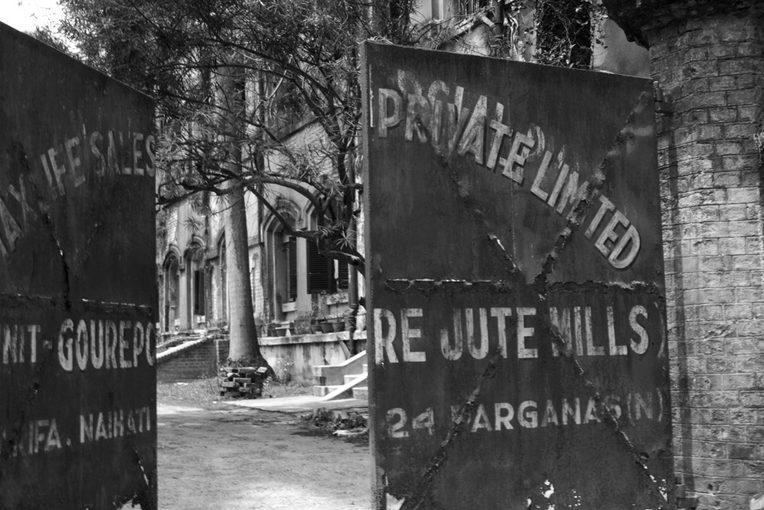
The Gate. The rusted gates of the dysfunctional factory remain open. However, an inquisitive onlooker will most likely be stopped from exploring once he or she comes to the attention of a few scattered guards. The sight of a camera hanging around my neck inevitably provokes an order to leave the premises, as entry is not allowed without permission from the court. While it is easier to enter the residential blocks, it is much more difficult to reach the production floors. Whether supervision really serves to guard the disputed premises or to protect the interest of its illegal residents and their undeclared activities is debatable. But, once one manages to get inside, one constantly interacts with the unfamiliar and unexpected according to one’s intention, level of engagement, and curiosity.
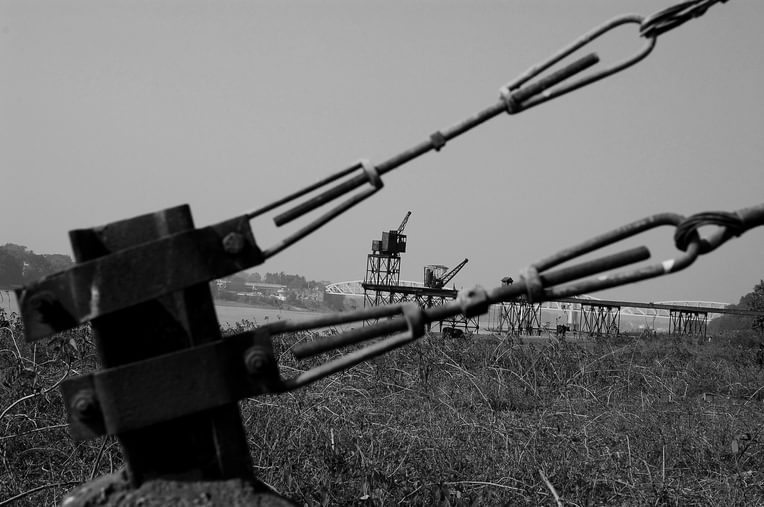
The Cranes. The abandonment of industrial infrastructure is the most obvious and omnipresent feature of the mill. It has permanently ceased to be part of wider networks of demand, supply, transportation, production, and consumption. A space once designated for industrial production has been converted into devastation, characterized by dysfunction and disorder.

The Track. The skeleton of a jetty along the river near Bandel Rail Bridge remains exposed. The riverbanks are marked by silent protrusions that will never regain the metallic sounds of levers and pulleys at work. The rusted cranes with their bars and rails were once the lifeline of export. They still withstand the humidity, indicating the quality of their British frames. Once used for the loading and unloading of raw materials and finished products, their connection to the river has altered permanently. The high tide, which used to carry commodities to the port of Calcutta from which they could be shipped abroad through the Bay of Bengal, now witnesses the corrosion of structures in their afterlife.
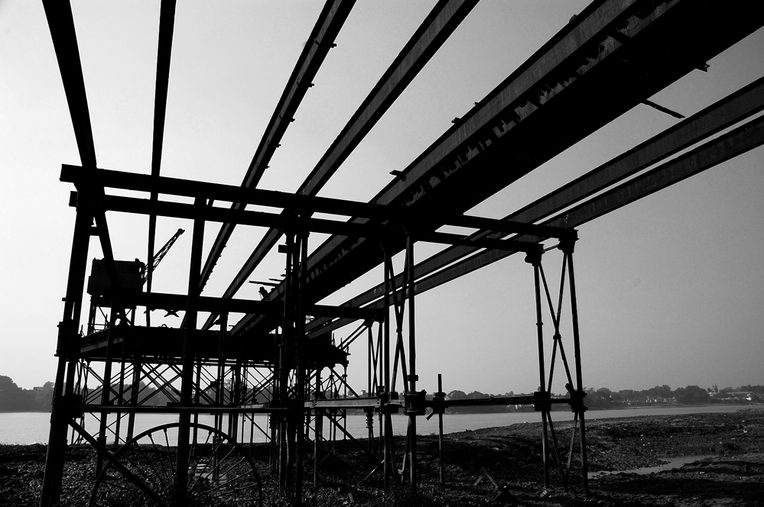
The Tracks from Below. These wild zones encourage loitering. But unlike designated historical sites, there are no souvenirs to be purchased, no assembly-line icons to be found. No chain of events is performed one after the other; no labor heroes are glorified; no history is textually or visually narrated. Information embedded in the out-of-placeness of things lays bare to be experienced through the senses.
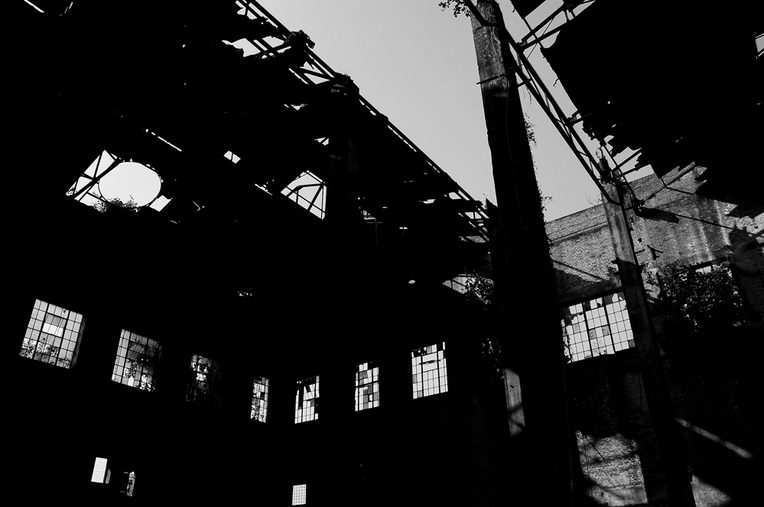
The Work Floor. The production floors are mostly barren. Over the passing decades, roofs and windows have surrendered to the forces of nature. Machines were removed long ago. Empty floors further amplify the sense of space, its conspicuous lack of purpose. Once used to support processes like softening, thinning, and strengthening the precious commodity of jute, the floors are now trapped under silent spells. Human activity— the fight for livelihood and the scramble for profit—has been replaced by an emptiness of the most desolate kind.
If order, discipline, and surveillance govern our regular existence and if the demarcation of spaces on the basis of their function determines our behavioral patterns, then industrial ruins are not only an exception to such rules but also a subversion of all kinds of spatial segmentation, fixity, and predetermined functionality. Things here are defunct and loose. It is everything that space in a regulated consumerist society is not. It is everything that a society obsessed with surveillance cannot imagine, even though the ruins may share proximity with the ordered and disciplined markets nearby. The antiauthoritarian characteristic is what makes it a utopian space, inviting the explorer to shed his or her restraints. In contrast to consumerist spaces, this is an exceptionally unconventional space that defies and disrupts administrators’ and planners’ ideas regarding good governance. Here, one has license to shout, scream, break, destroy, or remove without the fear of sanction. Even though adults might consider the mill to be risky and dangerous (just as my parents once maintained), it is actually risky but playful; dangerous but adventurous; forbidden but inviting; scary but spectacular.
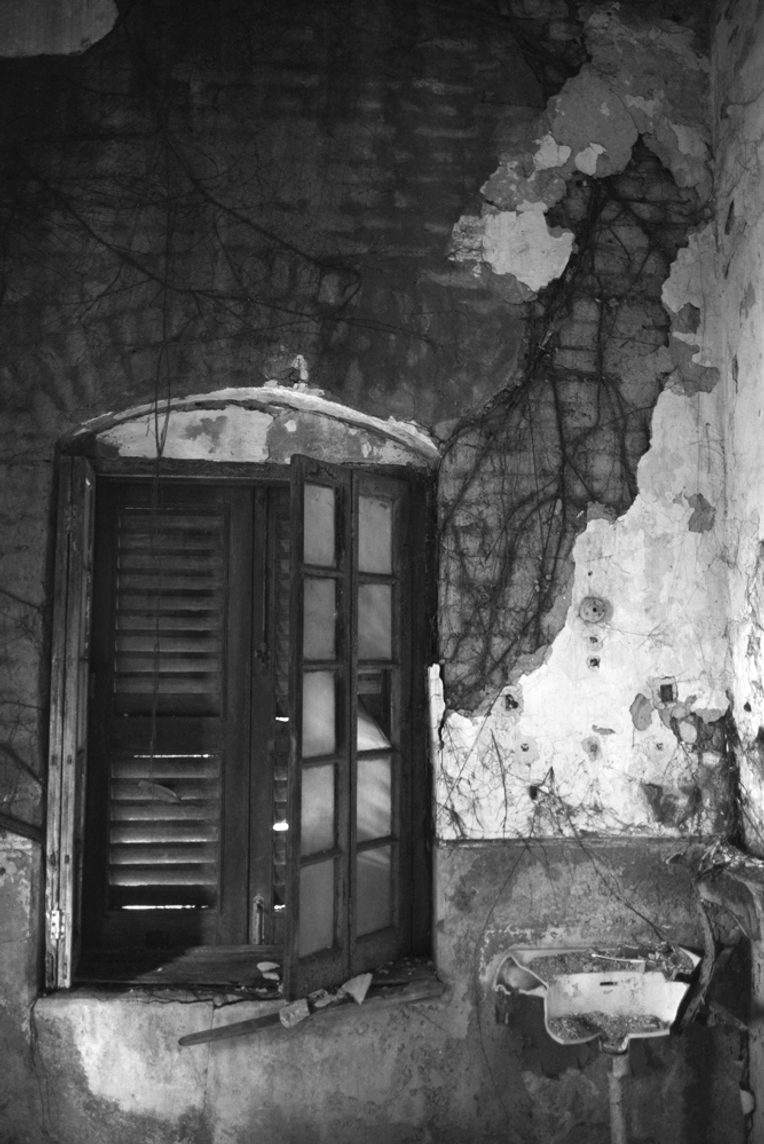
The Crumble. To find oneself not surrounded by people moving in a certain direction with a specific purpose, or by things with an assigned function, is to be in a space that is almost impossible to imagine in an era marked by a fast, dense network of material flows.
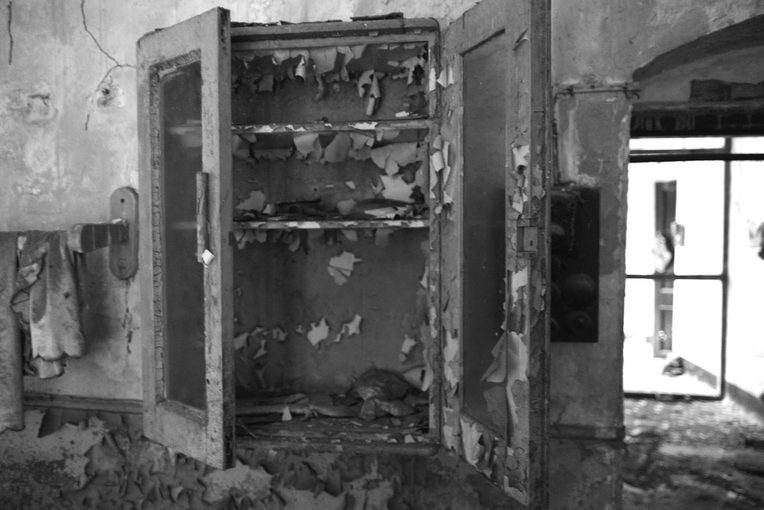
The Crumble. Here is a short list of the visuals of decay seen in abundance:
Damaged protective materials (doors, windows, tiles, paint, roof, etc.); fractured bricks, cracked floors, broken walls, collapsed pillars, fallen beams, peeling surfaces; rusted metals, crumbling pieces, stolen or sold assets and fixtures, paints converted into bubbles and blisters; exposed networks of what is otherwise supposed to be hidden (wires, pipes, lines, sewers)
One also hears wide-ranging echoes, bird and animal calls, metallic frictions, the sounds of crumbling leaves underfoot. Once separated from familiar sounds, unfamiliar decibels take over.

The Dysfunctional. Since nothing has an assigned space or functionality, nothing could possibly be out of place. The accumulative disordering of things challenges the normative visual ordering we expect. Beams of light pass through gaps, creating strange geometrical patterns that light up certain places during particular times of the day. Scatteredness is perhaps the only consistent pattern.
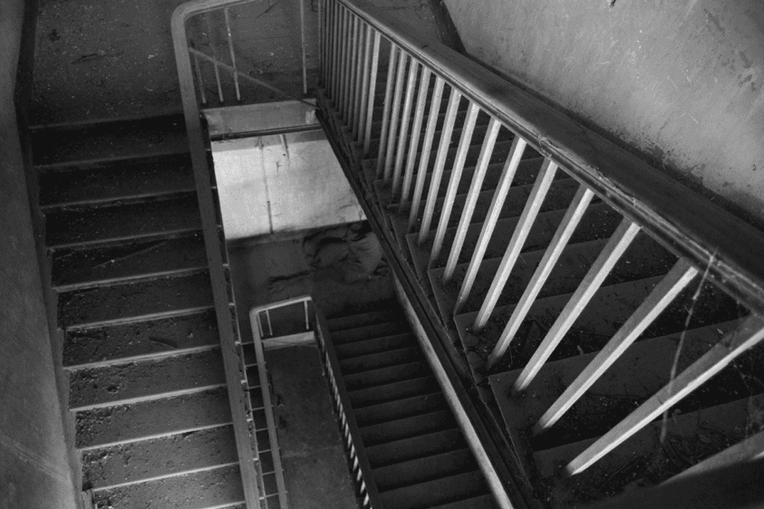
The Stairs. Amid this chaotic setting, the social hierarchy that organized this place emerges through the act of careful observation. One finds the remnants of the separation of spaces by the social and economic rank of those who occupied them. Factories attracted a migrant workforce, particularly landless peasants from the neighboring states of Bihar, Uttar Pradesh, and Orissa. They often lived in nearby slums before managing to move into company quarters. While most of the migrant workers lived in shantytowns around the factories, supervisors and managers enjoyed privileged housing and a quality of life that would make even today’s managers jealous. There are stairs that lead you to the debris that decorates a once-inhabited afterlife. Given the quality of the construction materials, many of the fixtures are still intact beneath layers of dust, spiderwebs, and forgotten pasts. Stairs often lead to spacious landing areas and broad balconies that overlook the courtyard.
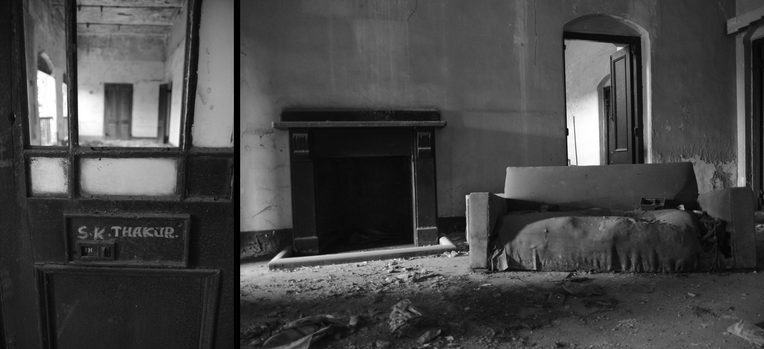
The Rooms. This three-story building with blocks of rooms on either side of the stairs is now occupied by workers’ descendants. They usually live on the ground floor, while the other rooms remain empty. Workers’ subordination to machines was complemented by hierarchies that structured work relations. The exercise of authority and control often emerged out of socio-spatial divisions and distances between the managers and the managed, which were established and maintained through signs of control. Rooms on the top floor had skylights and fireplaces, along with huge drawing rooms and kitchens.
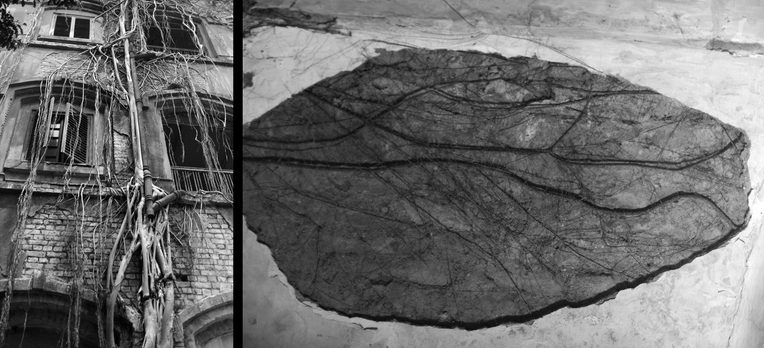
The Roots. Intruding banyan roots are a defining feature of this space: the unintended décor that forms an interior and exterior design in the absence of human presence. Like forgotten pathways used to access memory as one grows old, the network of roots visibly declares the death of an epoch. Tim Edensor (2005, 43) describes this process of roots, branches, and undergrowth taking over the ruin as “botanical colonization,” a process further intensified by the intrusion of stray animals, birds, and insects, which signify the breakage of the boundary between nature and culture within the ruin itself.
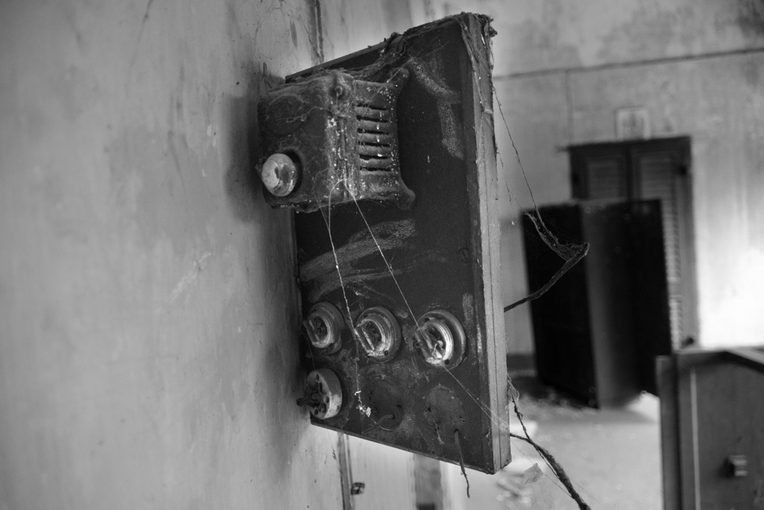
The Switchboard. Here, the notion of time perpetually inhabits a pause mode with an unaccounted past, an absent present, and a nonexistent future. Rooms are without electricity, and bathrooms will never be supplied with water again. Cupboards remain suspended in time with memories of their utility, as paint and tiles peel off like leaves from a dead tree. As humans abandon these spaces, the world of spiders, ants, and termites takes over.
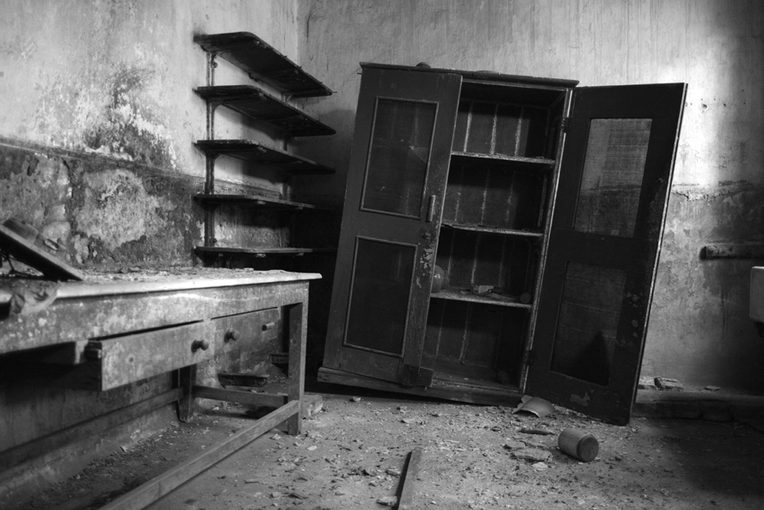
The Loss of Material Sovereignty. The impact of unruly elements and a lack of maintenance ultimately lead to what I call the loss of material sovereignty, in which materials eventually amalgamate in a generalized category of detritus due to their gradual fragmentation. They lose their distinct and singular identities. They decay and deteriorate further. The vulnerability of even the toughest materials gets exposed, as they remain surrounded by bits and pieces of their once unified selves, creating an incomprehensible rubble of strange and hybrid surfaces.
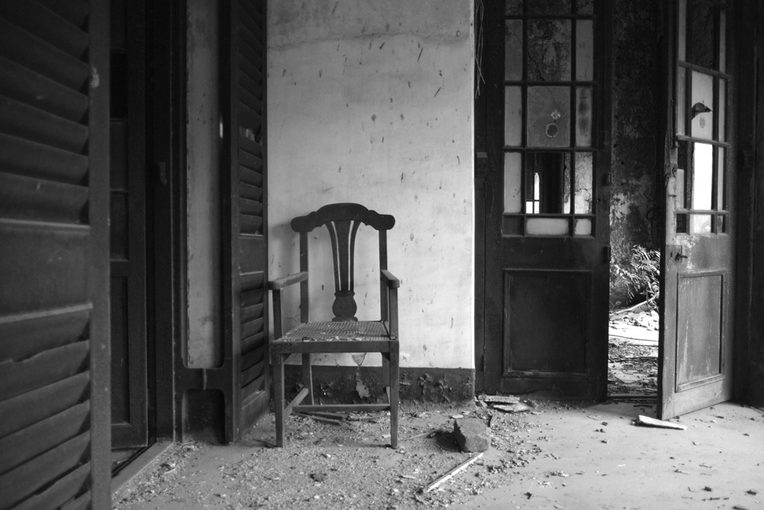
Objects Create Their Own Household. Human absence also elevates the status of abandoned objects and their traces. Objects create their own household, becoming protagonists desperate to strike up a conversation with an unexpected guest as if they were waiting to communicate, expecting the appearance of living beings at any time. Nameplates, chairs, calendars, sinks, windows, wardrobes, and refrigerators create a family of objects, tied together only by their uselessness.

The Calcutta singer Kabir Suman once composed a song called “Nadir Galpo” or “River’s Song”: “A river has a lot to say to the ghats [the steps that go into the water]. . . . Time condenses itself as moss on its steps.” Such an imaginative metamorphosis is apt for a space that belonged to the most dominating workforce of late nineteenth and early twentieth-century Bengal. To extend the imagination further, the reverse must be equally true: objects, trapped by obsolescence, freeze in time. The river witnesses evolution and degeneration as it continues to flow, for it has a journey that extends beyond the conversion of plants into the golden fiber. It points to a longer lifeline that can outlive those minuscule projects that are so important to us.
References
Bauman, Zygmunt. 2004. Wasted Lives: Modernity and Its Outcasts. Malden, Mass.: Wiley.
Buchli, Victor, and Gavin Lucas. 2001. Archaeologies of the Contemporary Past. New York: Routledge.
Chakrabarty, Dipesh. 1989. Rethinking Working Class History: Bengal, 1890–1940. Princeton, N.J.: Princeton University Press.
Edensor, Tim. 2005. Industrial Ruins: Spaces, Aesthetics and Materiality. New York: Berg.
Gross, David. 1992. The Past in Ruins: Tradition and the Critique of Modernity. Amherst: University of Massachusetts Press.
Harbison, Robert. 2015. Ruins and Fragments: Tales of Loss and Discovery. London: Reaktion Books.
Harvey, David. 1990. The Conditions of Postmodernity. Malden, Mass.: Blackwell.
_____. 2000. Spaces of Hope. Berkeley: University of California Press.
Harrison, Rodney, and John Schofield. 2010. After Modernity: Archaeological Approaches to the Contemporary Past. New York: Oxford University Press.
Fernandes, Leela. 1997. Producing Workers: The Politics of Gender, Class, and Culture in the Calcutta Jute Mills. Philadelphia: University of Pennsylvania Press.
Kennedy, Greg. 2007. An Ontology of Trash: The Disposable and its Problematic Nature. Albany: State University of New York Press.
Mah, Alice. 2008. “Landscapes and Legacies of Industrial Ruination.” PhD dissertation, London School of Economics.
_____. 2014. Port Cities and Global Legacies: Urban Identity, Waterfront Work, and Radicalism. New York: Palgrave Macmillan.
Massumi, Brian. 2002. Parables of the Virtual: Movement, Affect, Sensation. Durham, N.C.: Duke University Press.
Nora, Pierre. 1996. Realms of Memory: Rethinking the French Past, Volume 1, Conflicts and Divisions. Edited by Lawrence D. Kritzman and translated by Arthur Goldhammer. New York: Columbia University Press.
Olsen, Bjørnar, and Þóra Pétursdóttir. 2014. Ruin Memories: Materialities, Aesthetics and the Archaeology of the Recent Past. New York: Routledge.
Stoler, Ann Laura, ed. 2013. Imperial Debris: On Ruins and Ruination. Durham, N.C.: Duke University Press.
Strasser, Susan. 1999. Waste and Want: A Social History of Trash. New York: Holt Paperbacks.
Tamm, Marek. 2013. “Beyond History and Memory: New Perspectives in Memory Studies.” History Compass 11, no. 6: 458–73.
Tischleder, Babette B. and Sarah Wasserman, eds. 2015. Cultures of Obsolescence: History, Materiality, and the Digital Age. New York: Palgrave McMillan.
Yablon, Nick. 2009. Untimely Ruins: An Archaeology of American Urban Modernity, 1819–1919. Chicago: University of Chicago Press.